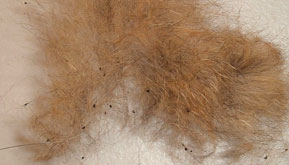Newborn dogs need a lot of care, in addition to being with their mother constantly. If the mother has lived in the field or if the puppies were collected shortly after birth, they could be exposed to parasites like fleas. Smaller puppies are easier targets of fleas because they provide the perfect environment for them – they are warm, produce moisture and have blood that serves as food.
Fleas are small insects that acts as external parasites to animals, and also to humans. They feed on the blood of their hosts, causing the skin to become itchy and irritated. Plus, fleas can be transmittable from one host to another, so if your dog has fleas, these parasites can attack you as well.
These parasites are not always easy to spot, so you may not know that your litter of small dogs could be infested with them. You can spot these problems if you observe that your newborn puppies are compulsively scratching. Because they are too small, they can’t scratch themselves well, so they tend to rub against their mother or their other siblings.
Eliminating fleas in puppies is a complicated problem, since they are still delicate. Because of this, many people wonder how to eliminate fleas in newborn puppies. You may think of the special products that help eliminate fleas on dogs, but you should understand that most anti-flea products are not suitable for newborn pups.
There may be products that are designed for puppies’ and adult dogs’ use, but even those may be too strong for dogs under three months. Newborn puppies are very sensitive to poisoning and overdose for these types of products. However, even if your little furry buddy is already three months old, only use anti-flea products when the label indicates that it is suitable for puppies at least three months of age. Usually, the dosage for medications would be lower for small dogs. Remember, very young puppies still do not have fully developed organs, so they cannot easily eliminate waste and toxins they have ingested.
Dealing with the fleas in your puppies
Since puppies are delicate, the more suitable way to get rid of their fleas is to remove them manually and eliminate them. You may also use anti-flea medications suitable for your puppy’s age.
1. Look for fleas in your puppies’ fur
You will eventually see these insects looking like black or brown spots and would run or jump between their hairs. Usually they can be found on the puppy’s neck, belly, underarms and genitals, so inspect these areas well. Also check if there are flea feces in there – you can find it if you moisten the puppy’s coat a little, and you will see small, immobile spots that turn reddish in color if it comes in contact with the water.
2. Bathe your affected puppies in warm water and anti-flea shampoo
Don’t make it too hot since newborns are sensitive to temperature; it must be just about the same temperature you’d use to bathe a human baby. The warm water will help you wash their hair better and force the fleas to come out of their fur. Shampoo them well and lather with gentle massages, but prevent foam from reaching their ears and eyes. It would be best to avoid shampooing their head altogether, because you have to avoid touching the top of their head that is still delicate.
A proper flea shampoo can help get rid of these pests. Arava Intensive Bio Care Flea and Ticks Botanical Shampoo is a great shampoo as it’s super safe for pets, making it delicate for little puppies. It contains a mild concentration of active natural ingredients like essential oils and Dead Sea minerals. This shampoo has a subtle, pleasant herb scent and uses a gentle formula.
Another puppy-friendly shampoo is Adams Plus Flea & Tick Foaming Shampoo. It’s made of the soothing, yet powerful combination, of oatmeal and aloe vera which is proven effective in killing fleas, flea eggs, flea larvae, ticks, and lice.
3. Remove their fleas using a special comb
Use combs with very fine spikes to eliminate fleas as well as lice and their eggs. Start at the puppy’s neck and comb one section at a time until you have covered its whole body and removed all of the fleas. But be careful not to comb them too tight, as it may damage your puppy’s skin. You also have to kill them as soon as you have removed them from your pet’s fur because if you don’t, they would go back in the same puppy or transfer to another.
4. Dry the puppy
You would have to dry your puppies well, since fleas like moisture. Repeat this process with each infected puppy of the litter, as well as their mother. Keep your pets clean to avoid being attractive to fleas.
5. Eliminate fleas at home
Once you got rid of the fleas from newborn dogs and their mother, it is important to also get rid of the fleas in their environment to avoid re-infection. You need to wash their beddings or carpets and replace it with clean ones. For additional layer of protection, you can use an anti-flea and tick home spray to kill any remaining fleas around your home that you don’t see.
Spray some of Vet’s Best Flea & Tick Pet & Home Spray indoors, especially on your dog beddings, crates, carpets, rugs and couches; and also outdoors on the porch or deck where your dog loves to stay. This is a plant-based spray that can kill fleas, flea eggs and ticks by contact, without the harsh chemicals present in most insecticides. This is made of essential oils such as peppermint oil and eugenol. You an even spray it on your dog’s coat and massage until the product reaches your dog’s skin.
Carpets and rugs that have been infested by fleas may still have live fleas sticking to it even after you have washed or vacuumed them. Use a powdered flea killer like Fleabusters, a boric-acid based product you can sprinkle your carpets, area rugs, couch, baseboards and other hard surfaces, to eliminate fleas. Leave it on overnight, then vacuum away the next day.
6. Apply topical flea treatment to your puppy.
For a long-term solution, you can eliminate fleas with a topical flea treatment for dogs, especially those recommended for your puppy’s age and size. Remember, medications like these are not yet appropriate for puppies that are too young. Topical spot-on treatments include squeezing a small vial of goo and applying it to the nape of your dog’s neck. These types of medicines can take 12-48 hours to kill fleas. It’s best to apply flea treatment at least 2 days after the dog’s bath, to give the dog’s skin some time to produce more oil. The natural oil on the dog’s skin can help spread the flea treatment over their bodies. Or you can apply it right away (given that your dog’s fur is clean), then wait for at least two days before giving your dog a bath.
One vet-recommended dog flea drops in the market is Frontline Plus. This flea and tick treatment is available in different variants suitable for small (5-22 lbs.), medium (23-44 lbs.), large (45-88 lbs.) and extra-large dogs (89-132 lbs.). It’s a formulation made with fipronil and (S)-methoprene to kill adult fleas and ticks and also their eggs and larvae. It’s suitable for puppies and dogs 8 weeks and older. One box contains three doses, and just use one dose and it can give your puppy protection for the whole month.
Another great flea-and-tick-killer for puppies is Bayer Advantage II. Like Frontline Plus, it’s also available in different variants depending on the size and weight of the dogs, but this one’s appropriate for dogs and puppies that are 7 weeks and older. Its active ingredients include imidacloprid and pyriproxyfen. A box contains four doses, and it can start working within 12 hours after application. One dose is good for 30 days, and you only need to reapply the next month.
If you prefer a medication made from natural ingredients, Natural Chemistry Flea and Tick Squeeze on for Dogs is for you. This treatment is made with natural ingredients such as cinnamon oil, mint oil and lemongrass oil. One box contains 5 months’ worth of treatment. It’s a great repellant and killer of fleas while preventing unknown chemicals to be absorbed by your puppy’s skin.
Preventing infestation of fleas
The environment in which the puppies live could be rich in flea eggs, larvae and pupae just waiting to reach maturity, and you can’t see them. If your puppy has been infested with fleas before, or if you have discovered that other dogs in your community are ridden with fleas, you have to do something to prevent your puppy from being infested too.
First of all, start by keeping your home clean and dry. This also applies to places where your pet spends much time, like your car, garage, basement or pet carrier. Always vacuum your doggy areas thoroughly, especially below the drapes, under furniture edges and your pet’s sleeping area. Vacuuming can remove up to 50% of flea eggs.
Use an anti-flea spray or insecticides on your home (as mentioned earlier in #5) or directly in your dog’s coat. Terra Pet Naturals 100% Pet Naturals of Vermont – FLEA + TICK Repellent Spray can help prevent and control fleas, ticks and other pests that can dwell in your dog’s fur. This product is purely made of natural materials such as essential oils blended with apple cider vinegar. It works effectively in repelling pests, and it’s gentle for puppies and dogs with sensitive skin.
You can also stick with the classic flea prevention method of having your puppies wear a flea and tick collar. Arava Flea & Tick Prevention Collar is a great choice for a flea and tick collar, since this is made of premium natural and active herbal ingredients and essential oils, such as peppermint, lemongrass, cinnamon, geranium and more. Essential oils will be infused using a micro-injection technology using a slow-release process, making the collar effective for up to 5 months.


